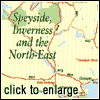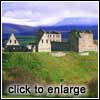|
The Road to Inverness (A9)
The first stop is the village of Dalwhinnie, the highest
Highland village at 1,173ft (358m) above sea level. Dalwhinnie Distillery is one
of the few and most prominent buildings and the first of many whisky distillers that
stand close to the banks of the River Spey. It contains a small visitor centre showing
the social history of the village as well as offering visitors a welcomed and warming
dram.
This area's history was most noticeably affected with
the arrival of General Wade and his squad of road builders in July 1724. By December
of that year he had finished his survey of the central Highlands and reported his
plans to 'reduce the Highlands to obedience'. Roads and bridges were built between
barracks to facilitate better communication of 'His Majesty's troops' and between
1725 and 1735, 250 miles (402km) of relatively good surfaces were laid.
Today, the A9 is the main North Road, a fast-flowing
combination of dual and single carriageway that is notorious for thoughtless drivers
in a hurry to reach Inverness or Perth in the opposite direction. A new scheme of
'speed cameras' is helping to restrain those with a 'heavy foot' but care should
always be taken on this route.
Along the River Spey
 Just off the A9 at Ralia, near Newtonmore, is a good rest
stop with a picnic area and Tourist Information Office. There are viewpoints of the
surrounding mountains and, through the summer months, an exhibition is mounted in
the adjacent building reflecting facets of the local community. To best appreciate
the serenity and stirring panoramas of Speyside at a much slower pace, it is a good
idea to come off the A9 here and use the old A9 route. Just off the A9 at Ralia, near Newtonmore, is a good rest
stop with a picnic area and Tourist Information Office. There are viewpoints of the
surrounding mountains and, through the summer months, an exhibition is mounted in
the adjacent building reflecting facets of the local community. To best appreciate
the serenity and stirring panoramas of Speyside at a much slower pace, it is a good
idea to come off the A9 here and use the old A9 route.
Speyside is thought of as Shinty country, a Scots
game more ancient than golf and still very popular in this region. It has lead to
an unusual incidence of left-handed golfers (40 per cent) using the facilities at
Newtonmore Golf Club. These 18 holes adjacent to the River Spey are a regular venue
for the Scottish left-handed golf championships.
Newtonmore is also the home base for the MacPherson
clan and there is a small museum dedicated to them in the village. Apart from peace
and quiet, there is also a new attraction at the north end of the village, Waltzing
Waters. You could not fail to see its shimmering frontage, somewhat of an anomaly
in this sober little Victorian hideaway.
Inside is an elaborate though sometimes comical display
of dancing water fountains and coloured lights, presented in a theatre configuration
with accompanying Scottish and Classical music. It takes itself, at times, rather
too seriously and that is where the humour comes in. There are various exhibits in
the foyer and a good little cafe upstairs.
Kingussie
 A couple of miles further on is the village of Kingussie.
The name is derived from the Gaelic meaning 'the Head of the Pinewood'. Before the
arrival of the railway in 1890, Kingussie was a centre for weaving and spinning.
Along with Newtonmore, it became a popular tourist stop with wealthy English families
journeying to the Highlands by train, bringing their household from the south and
setting up home here for the summer. Shooting and fishing, as well as taking the
beneficial Highland air, were popular. Beautiful Victorian houses built as holiday
homes are still evident. A couple of miles further on is the village of Kingussie.
The name is derived from the Gaelic meaning 'the Head of the Pinewood'. Before the
arrival of the railway in 1890, Kingussie was a centre for weaving and spinning.
Along with Newtonmore, it became a popular tourist stop with wealthy English families
journeying to the Highlands by train, bringing their household from the south and
setting up home here for the summer. Shooting and fishing, as well as taking the
beneficial Highland air, were popular. Beautiful Victorian houses built as holiday
homes are still evident.
One of Kingussie's main attractions is the Highland
Folk Museum found just off the main street. Originating on the island of Iona, the
museum moved around the Highlands quite a bit before settling in Kingussie in 1935.
During those travels, it has amassed a fascinating collection of items that give
a rare insight into aspects of ancient Highland life.
In the Hebridean Black House from Lewis, a replica
of the houses used around 200 years ago, there are short-legged stools to keep the
residents lower that 'the peat reek' or smoke from the open fire as well as an adjacent
byre where the tenant's livestock was kept. In the main building of the museum, there
is a farming exhibition and often varying demonstrations of traditional crafts put
on by staff who take an active role in bringing the museum to life.
 The nearby ruins of Ruthven Barracks (or the 'Red Place')
are set on a man-made mound, backed by the Cairngorm Mountains. In their time they
commanded one of the major crossing sites on the Spey and this is still easily appreciated
when you see them towering over the Spey valley. The nearby ruins of Ruthven Barracks (or the 'Red Place')
are set on a man-made mound, backed by the Cairngorm Mountains. In their time they
commanded one of the major crossing sites on the Spey and this is still easily appreciated
when you see them towering over the Spey valley.
It was built by government militia in 1718 as part
of the Highland campaign to control the Jacobites and used as a staging post for
troops and horses. To the followers of the Jacobite cause, however, this was a stain
on their land, a symbol of suppression by the House of Hanover.
In February 1746 the Jacobite army took control of
the barracks and blew them up to avoid them falling back into English hands. Two
and a half months later, following their dire defeat at the battle of Culloden, the
tattered remains of Prince Charles's forces came back to Ruthven expecting to carry
on the campaign.
But there, they received orders to disperse as the
young pretender made his escape back to France. 'Let every man seek his own safety
in the best way that he can,' was the word from the retreating commander. The barracks
remain roofless and bare, much as they were left in those pitiable days.
The River Spey, meandering through this part of the
area, has been a keynote in Scottish and Highland history and amply contributes to
the magnificent scenery surrounding it. It commences its 98 mile (158km) journey
to the Moray Firth at Loch Spey in the heart of the Monadhliath Mountains passing
through the communities of Newtonmore, Kingussie, Aviemore, Boat of Garten, Grantown
on Spey, Fochabers and finally entering the sea at Spey Bay.
Behind Kingussie, the Monadhlaith Mountains, reaching
from the Spey Valley over to Loch Ness to the west, appear quite desolate, littered
with peat bogs and glacial debris scattered over a granite base.
The Cairngorms
The Cairngorms on the other side of the Spey Valley
are more impressive, higher and offering perhaps one of the most magnificent landscapes
in Europe. They reach to over 4,000ft (1,219m) yet, throughout the years, have been
more accessible to sportsmen and sightseers than their neighbouring ranges. Now they
are a major tourism attraction. As well as low level walks through the forest to
high mountain climbing for experienced mountaineers, there is also shooting, fishing,
camping, canoeing and, through the winter months, the area's biggest draw, skiing.
About 20 miles (32km) south-east of Inverness and
80 miles (129km) north of Perth, at the foothills of the Cairngorms, is Aviemore.
The village has long been a nodal point on the tourist map for this part of the Highlands,
although, in recent years, it has been criticised for its rather tired and disagreeable
1960s style architecture. This problem is currently being addressed and there is
no doubt that it will return to the favoured resort it was when first established
some 30 years ago. The majority of the concrete blocks you see were devised and built
as part of a grand plan to accommodate more tourists and extend the holiday season
especially to take advantage of the nearby skiing facilities. Originally, the village
was little more than a few cottages and a couple of hotels but this local initiative
has created a haven of bistros, bars, amusement arcades and numerous hotels. The
Aviemore Centre contains an ice rink, swimming pool, theatre and cinema so there
is always something to do even in the foulest weather.
Outdoor pursuits are found at Glen More, which is
part of the Cairngorm National Nature Reserve, a few miles up the glen past Coylumbridge.
On Loch Morlich you find sailing and windsurfing while the surrounding woods and
glens offer walking and more strenuous hiking in the higher hills. There are plenty
of loch-side parking areas with adjacent coarse sandy beaches in which to paddle.
If you wonder where reindeer go when they are not busy over the Yuletide, then visit
the Cairngorm Reindeer Centre found near Loch Morlich. The herd was established here
in the early 1950s and has grown to 500. The young calves are born in May so this
is a good time to visit.
The nearby Rothiemurchus Estate has done exemplary
work in providing an outdoor experience for visitors and there is a host of interesting
activities presented here. Forest and wildlife walks are organised with rangers through
the ancient Caledonian Pinewoods or following the River Spey. Other more educational
projects are available as well as farm tours, estate tours, clay pigeon shooting
and fishing. The Rothiemurcus Visitor Centre is found on the B970 just before Coylumbridge,
Tel: 01479 810858.
Still on the banks of the River Spey, a few miles
north east of Aviemore, is a triangle of holiday villages, Carr Bridge, Boat of Garten
and Grantown-on-Spey.
Carrbridge
Carrbridge comprises a few tasteful cottages lining
the main street with a hotel, shop and garage but at its south end is the Landmark
Visitor Centre. This 'mini-theme park in the forest' seems to expand every year with
new attractions.
Besides the nature and tree top trails which are intended
to be educational but, for children, tend to be a fun romp through the woods on specially
constructed walkways, there is a presentation on the forestry industry including
a steam powered sawmill and a tree-felling display. There is a good restaurant and
shop along with a Highlander multi-vision show and exhibition telling the story of
man's struggle to survive in this once remote and infertile area.
In the village, you may find it hard to believe that
the thin sliver of a bridge crossing over the River Dulnain, was the original pack
horse route from the north and south. Local teenagers, despite the obvious dangers,
delight in climbing up and jumping off the bridge into the peaty, swirling depths
below.
Grantown-on-Spey
Grantown-on-Spey is another Victorian resort, evident
as soon as you enter the wide, well designed main street. For a more peaceful Highland
holiday this is the place to come, away from the flurry of Aviemore.
Fishing and golf are the main activities here with
investigation of the nearby Speyside whisky distilleries an enjoyable diversion.
To get onto the Malt Whisky Trail from Speyside, follow the A95 east and enter an
area rich in distilleries, once the stronghold of the illegal distilling trade.
The Glenlivet, one of the most popular Scotch whiskies,
dates back to the early 1800s founded by an illicit distiller and smuggler, George
Smith. The distillery and centre make visitors most welcome, the displays are educational
and samples, on a cold day, most appreciated. For eating, try Smiffy's licensed restaurant
in Grantown's town square for its fish and chips or the Tiree Hotel, opposite, for
a more sedate meal.
 Boat of Garten might seem an odd name for a Highland village,
but a small ferry once operated here, crossing the River Spey until a bridge was
built in the late nineteenth century. The 'Boat', as it is more affectionately known,
is still the northern terminus for the Strathspey Steam Railway leaving from Aviemore
and taking around half an hour. Boat of Garten might seem an odd name for a Highland village,
but a small ferry once operated here, crossing the River Spey until a bridge was
built in the late nineteenth century. The 'Boat', as it is more affectionately known,
is still the northern terminus for the Strathspey Steam Railway leaving from Aviemore
and taking around half an hour.
There is a nostalgic old station at Boat of Garten
and various carriages in disparate states of repair. Loch Garten nearby, is the spot
where Scotland's once rare Ospreys return year after year to raise clutches of clicks,
gradually, along with other pairs, repopulating the Highlands with this beautiful
bird of prey.
|




